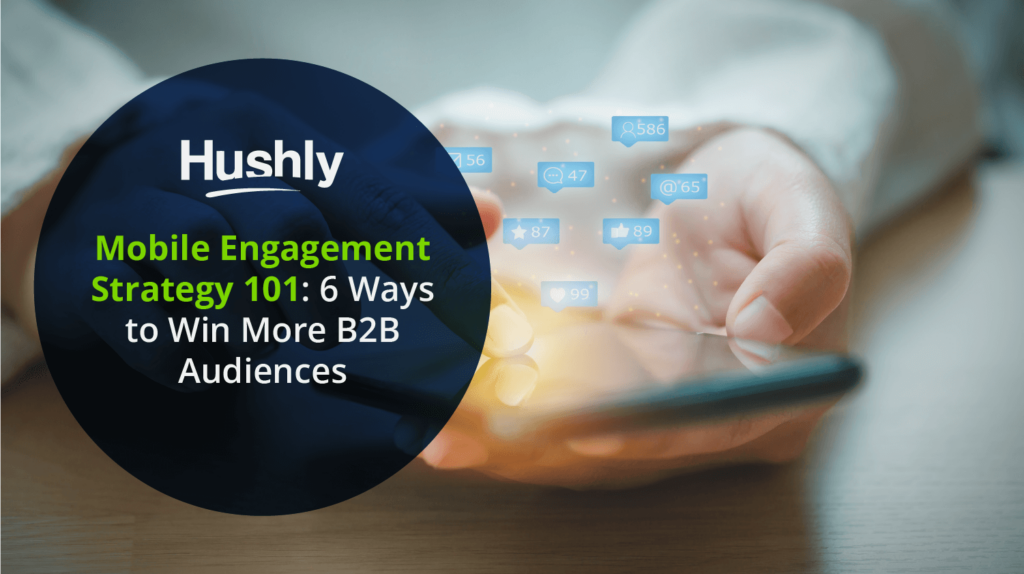A business owner spots an ad for your software and is convinced enough by the potential value that he makes a note to research your website later.
He doesn’t remember the note until a few days later when he’s at home going over emails on his phone, and it’s here that he finally has the time to look at your website.
So, what happens when he opens your mobile website?
If you want this hypothetical prospect to find a clean, responsive, and personalized experience that will convince him to pull the trigger on the deal, then you need a mobile B2B engagement strategy that will provide just that.
Today’s guide will explore the intricacies of mobile engagement strategies, share with you some important statistics and information, and provide 6 steps to begin creating your own mobile engagement strategy.

What is B2B Mobile Engagement?
Mobile engagement refers to building a customer experience targeting mobile users and platforms.
This means building a mobile user interface on your website, creating apps that facilitate orders or subscriptions, and pushing mobile-specific promotions and offers.
The ultimate goal of B2B mobile engagement is to create a seamless user experience that blends the power and responsiveness of desktop experience with the convenience of mobile devices.
Does Your Business Need a B2B Mobile Engagement Strategy?
Hushly believes that every business with important B2B operations implements a robust mobile engagement strategy.
Customers count every interaction with your digital presence (mobile or desktop) as part of your customer experience.
Think about it as an opportunity cost. Every time a B2B user has a negative experience with your company, their odds of doing business with you fall. The time and money spent generating a B2B customer’s interest can quickly be lost when they encounter a subpar mobile experience.
If a customer wants to spend money on your product and they encounter some obstacle on the way to it, such as a poorly optimized mobile interface or a slow, unresponsive app, they’ll see your company as incompetent and quickly find somewhere else to spend it.
Crafting a mobile engagement strategy is all about avoiding scenarios like these.
B2B Mobile Users vs. B2B Desktop Users
B2B mobile and desktop users share some essential distinctions you should understand before beginning to craft your mobile engagement strategy.
B2B customers are interested in your product, have the time and wherewithal to engage with you on it, and are willing to be impressed by a great pitch. This much is true regardless of how they are browsing your website.
However, while the typical desktop user is on your site intentionally, the mobile user might steal a moment between meetings or even be at home after work.
Mobile Users Are Desktop Users, Too
Your desktop and mobile operations are not in competition. They should be viewed as two avenues to deliver the same information about the value of your product.
Multi-channel engagement is desirable and likely to occur among savvy B2B users who will spend days and weeks researching before making a final purchase decision.
If a customer has to spend hours on your website, the odds of them opening it up on a mobile device sooner or later skyrocket. You must be prepared when this happens.
Mobile Users Are Distracted Compared to Desktop Users
Mobile users are constantly under siege by notifications, and at any time, they could have their attention compromised by a phone call or other instruction.
You should account for this with pithy, direct information that immediately speaks to the value your company can add to theirs. This way, even if they are distracted, they should be incentivized to return.
Some Key Stats About B2B Mobile Users
Here are some key stats about mobile B2B users that should speak for themselves:
- Mobile users currently represent 30% of all web traffic.
- 9 of 10 executives use smartphones for day-to-day business.
- 25% of executives say they’re using mobile devices to research potential purchases of more than $100,000
6 Ways to Win More B2B Audiences with Mobile Engagement
Here are 6 stellar ways to improve your B2B mobile customer engagement.
1. Optimize Your Mobile UX
It’s not enough to just have a mobile interface. It’s the bare minimum that savvy B2B customers will expect.
You should focus on optimizing your mobile experience across all kinds of devices. Test your mobile experience often for a firsthand perspective of how it’s working.
2. Support Chat on Mobile Platforms
Finding support from a company representative should be simple, no matter how the customer engages with you. Implementing an automated support chat system is a simple way to accomplish this on mobile websites or applications.
B2B customers who find your website on their mobile devices might not always do this during work hours. An automated system that offers essential assistance and can facilitate human contact when more help is needed can save conversion that otherwise would have been lost.
3. Provide Updates on Process Completion
Mobile users are constantly distracted, but mobile B2B users will be distracted even more often, thanks to their status and responsibilities.
A B2B customer completing an order form on your mobile website or application should be able to tell how far along in the process they are.
Along these lines, it should be possible to pause an order and return to it later so that oft-distracted executives can pick up where they left off.
4. Keep Information Gathering to a Minimum
Mobile users won’t have a great experience if they constantly have to type long strings of information on a phone keyboard.
Try to keep information gathering to a minimum for mobile users. Offer to have more involved information gathering through another channel such as your desktop operation or email.
5. Promote Multi-Channel Engagement
All of your channels should be integrated with one another. There should never be a feeling of dissonance or competition between your mobile and desktop sites.
Instead, look for ways to promote each one at all times. Look at this as a way to demonstrate the consistently high quality of your product to your prospective customers.
6. Hushly
Hushly knows mobile engagement.
We recently released a mobile performance report detailing key information about how Hushly solves the mobile engagement problem.
Hushly can manage and integrate your desktop and mobile websites under one clean, responsive, and data-driven platform.
Our self-nurturing landing pages attract more mobile users, engage them more, and convert at a higher rate than standard webpages.
B2B Customers Need More
B2B customers are a challenge and an opportunity. The stakes are higher, and the decisions come more slowly and deliberately.
However, this means that the hours, days, and weeks your B2B prospect spends with you are an excellent opportunity to demonstrate the value your company can offer them.
Start your mobile engagement strategy to create a cohesive and comprehensive user experience, and B2B customers who demand more from you will be the first to notice.
Curious to see how Hushly can make your content engagement strategy simpler? Contact us today to find out.




